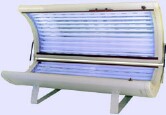
THURSDAY, March 25 (HealthDay News) — Recent calls for the U.S. Food and Drug Administration to clamp down on tanning bed use will heat up again Thursday as an agency panel debates new restrictions on the devices, which some health experts say contribute to cancer.
“We are hoping the FDA will reclassify tanning beds,” said Dr. Allan Halpern, vice president of the Skin Cancer Foundation.
Currently, tanning beds are classified as class I medical devices, “which means these cancer-causing machines are in the same category as tongue depressors and elastic bandages and subject to few regulations and little oversight,” the foundation noted in a news release.
On Thursday, the General and Plastic Surgery Devices Panel — part of the FDA’s Medical Devices Advisory Committee — will look over the latest data on the risks of ultraviolet (UV) ray exposure from tanning beds. According to the agency, there is a growing body of evidence that shows an association between skin cancer and the use of tanning lamps.
For its part, the Skin Cancer Foundation would like to see the classification of tanning beds changed to a class II device. For one thing, that could prevent the devices from containing mirrors, which amplify the power of UV exposure.
In addition, the foundation wants tanning beds to be manufactured and labeled in such a way that the public is better educated about their danger. They also want manufacturers to keep a registry monitoring the use of their products.
“UV light is a known cause of cancer,” Halpern said. “That’s recognized by the U.S. government, by the World Health Organization (WHO). And what tanning beds do is deliver UV light.”
On the other side of the debate, John Overstreet, executive director of the Indoor Tanning Association, said the industry is already well-regulated.
“We think the FDA does a pretty good job of regulating the industry. They have regulated the industry for 20-plus years,” Overstreet said. “There is a lot of misinformation about the industry,” he added.
Overstreet said his association will be testifying at the committee meeting. “We’ll address this whole myth about this relationship between melanoma skin cancer and indoor tanning, which is speculative at best,” he said.
But last summer, a report from the WHO’s International Agency for Research on Cancer moved tanning beds to its highest cancer risk category — “carcinogenic to humans.” Previously, the agency had classified sunlamps and tanning beds as “probably” carcinogenic, so the move put the devices a notch higher in terms of risk.
“The use of tanning beds can be deleterious to your health and we hope to encourage governments to formulate restrictions and regulations for the use of tanning beds,” report coauthor Beatrice Secretan, from the Cancer Monograph Working Group at the International Agency for Research on Cancer in Lyon, France, said at the time.
Halpern noted that the use of tanning beds by young girls and women is growing — as is their incidence of skin cancer. “There is one calculation that as many as a quarter of the melanomas in young women can be attributed directly to tanning bed use,” he said.
Another expert agreed.
Dr. Jeffrey C. Salomon, an assistant clinical professor of plastic surgery at Yale University School of Medicine, said: “I never recommend tanning bed usage to my patients. To me, it would be like recommending smoking to a patient.
“UV radiation damages the DNA in the skin and while it may take years for that DNA damage to manifest itself as a skin cancer, it is still a preventable risk, similar to smoking,” he added. “And like smoking, we have an obligation as a society to protect our youngest citizens from a known cancer risk by any legal means.”
Some people — including Halpern — would like to see tanning beds banned completely. “At a minimum we would like to see them banned for people under the age of 18,” he said.
But Indoor Tanning Association spokesman Overstreet begged to differ, citing studies that he said show that exposure to UV radiation may actually protect people from developing melanoma.
There are risks from exposure to UV radiation, he said, “but there are also benefits involved with being exposed to UV light. There’s no doubt about that,” he added.
“Without UV light you cannot live,” Overstreet said. “How much you need varies from person-to-person, from skin type to skin type — like anything else in life, pursue it with moderation.”
A bill introduced in Congress on Jan. 26, the Tanning Bed Cancer Control Act, also aims to put new restrictions on tanning bed use.
“Tanning beds are the cigarettes of our time: cancer-causing and poorly regulated,” Rep. Carolyn Maloney (D-NY), one of the chief sponsors of the bill, said in a statement.
Currently, the FDA and the U.S. Federal Trade Commission (FTC) each regulate tanning beds and sunlamps. The FDA regulates labeling of the devices and the FTC regulates advertising claims about the devices.
The FDA currently requires tanning salons to direct all customers to wear protective eye goggles and advises consumers to limit their exposure to tanning devices, and avoid them if you have certain medical conditions such as lupus or diabetes, or are susceptible to cold sores.
In addition, the FDA requires labels on these devices that warn of skin aging, skin cancer and eye injury. In 2007, the FDA began a review of these warnings and is considering strengthening its warnings about the risk of skin cancer and eye damage, according to the agency.
More information
There’s more on skin cancer at the American Cancer Society.

